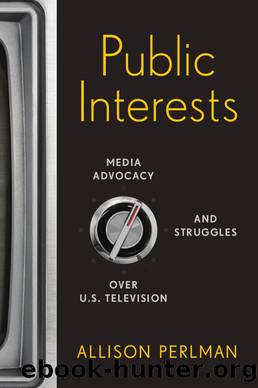Public Interests by Allison Perlman

Author:Allison Perlman [Perlman, Allison]
Language: eng
Format: epub
Tags: Social Science, Media Studies, Political Science, Political Process, Media & Internet, Civil Rights, Ethnic Studies, General, Women's Studies
ISBN: 9780813572314
Google: NZzeDAAAQBAJ
Publisher: Rutgers University Press
Published: 2016-05-01T04:25:20+00:00
Media Deregulation and the Culture Wars
Diversity, as a plank of broadcasting policy, was not a panacea. Much as Justice Marshall opined in the Bakke decision, to legitimate race-conscious policies under the rationale of âdiversityâ was to disavow how affirmative action had sought to remedy deep, long-standing, structural forms of inequality; diversity, instead, valued a multiculturalism of benefit to all, premised on the assumption that the mixing of different groups of people would diminish societal tensions. Still, for groups like the NAACP, appeals to diversityâa long-standing public interest goal of broadcast regulationâwere a means to retain policies that at least recognized the paucity of minority participation in broadcasting. Though these policies were not explicitly remedial, and thus were somewhat unmoored from the history of discriminatory practices that necessitated their creation, they signaled an effort to redress the profoundly inequitable distribution of resources within the broadcasting sector and to recognize how this distribution affected the images, narratives, and perspectives to circulate over the airwaves.
Diversity for the NAACP, therefore, was inseparable from the long history of racial injustice in the United States. This was a point that the organization made in its myriad attempts to slow the tide of deregulation and to demonstrate the interconnection between media policy and civil rights. This history, for the NAACP, could not be swept away by assumptions of an already realized level playing field or by an embrace of a liberal individualism that sought to deny the import of racial difference in how people make sense of the world and their place within it. This history necessitated continued consideration of racial difference in media regulation, even or especially in the face of a neoliberal faith that free markets, unfettered by state intervention, would better serve the needs of broadcast audiences.
This history also offered a potential retort to the claims of people like the KFUO listeners that to reduce diversity to racial diversity was to misunderstand the contours of American pluralism, which included diversity of faiths, diversity of educational backgrounds, and diversity of taste and interests. To focus only on race as a vector of difference was to diminish other forms of diversity and to continue to privilege a group of people who had borne the fruit of interventionist government policyâof a minority rights revolutionâfor more than two decades. What of people of faith desirous of broadcasting stations serving their needs? Was not religious diversity a meaningful form of diversity as well? While the NAACP may claim that Lutherans had not been subject to the same historical forces as African Americans, and had not borne the brunt of analogous forms of oppression, such claims by the 1980s were wearing thin on populations who since the 1970s had begun to resent the affirmative uses of state power to address racialâand genderâinequality. The Lutheran Church case most pointedly pitted racial diversity against religious diversity, the station and its listeners feeling especially aggrieved that African Americans continued to make claims of injury in the context of a media landscape that seemed
Download
This site does not store any files on its server. We only index and link to content provided by other sites. Please contact the content providers to delete copyright contents if any and email us, we'll remove relevant links or contents immediately.
The Secret History by Donna Tartt(18070)
The Social Justice Warrior Handbook by Lisa De Pasquale(11938)
Thirteen Reasons Why by Jay Asher(8411)
This Is How You Lose Her by Junot Diaz(6407)
Weapons of Math Destruction by Cathy O'Neil(5795)
Zero to One by Peter Thiel(5453)
Beartown by Fredrik Backman(5301)
The Myth of the Strong Leader by Archie Brown(5212)
The Fire Next Time by James Baldwin(4996)
How Democracies Die by Steven Levitsky & Daniel Ziblatt(4940)
Promise Me, Dad by Joe Biden(4897)
Stone's Rules by Roger Stone(4826)
100 Deadly Skills by Clint Emerson(4657)
Rise and Kill First by Ronen Bergman(4534)
A Higher Loyalty: Truth, Lies, and Leadership by James Comey(4529)
The David Icke Guide to the Global Conspiracy (and how to end it) by David Icke(4358)
Secrecy World by Jake Bernstein(4352)
The Farm by Tom Rob Smith(4300)
The Doomsday Machine by Daniel Ellsberg(4228)
